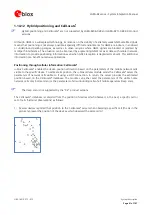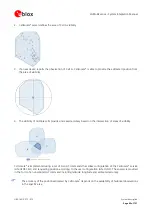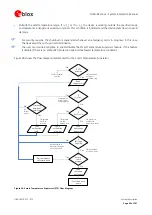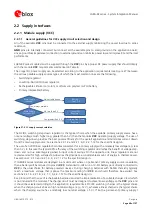
LARA-R2 series - System Integration Manual
UBX-16010573 - R12
Design-in
Page 74 of 157
2.2.1.4
Guidelines for VCC supply circuit design using a rechargeable Li-Ion or Li-Pol battery
Rechargeable Li-Ion or Li-Pol batteries connected to the
VCC
pins should meet the following prerequisites to
comply with the module
VCC
requirements summarized in Table 6:
Maximum pulse and DC discharge current
: the rechargeable Li-Ion battery with its related output circuit
connected to the
VCC
pins must be capable of delivering a pulse current as the maximum peak / pulse current
consumption during a Tx burst at the maximum Tx power specified in the
LARA-R2 series
Data Sheet
[1], and
must be capable of extensively delivering a DC current as the maximum average current consumption specified
in the
LARA-R2 series
Data Sheet
[1]. The maximum discharge current is not always reported in the data sheets
of batteries, but the maximum DC discharge current is typically almost equal to the battery capacity in amp-
hours divided by 1 hour.
DC series resistance
: the rechargeable Li-Ion battery with its output circuit must be capable of avoiding a
VCC voltage drop below the operating range summarized in Table 6 during transmit bursts.
2.2.1.5
Guidelines for VCC supply circuit design using a primary (disposable) battery
The characteristics of a primary (non-rechargeable) battery connected to the
VCC
pins should meet the following
prerequisites to comply with the module’s
VCC
requirements summarized in Table 6:
Maximum pulse and DC discharge current
: the non-rechargeable battery with its related output circuit
connected to the
VCC
pins must be capable of delivering a pulse current as the maximum peak current
consumption during a Tx burst at the maximum Tx power specified in the
LARA-R2 series
Data Sheet
[1], and
must be capable of extensively delivering a DC current as the maximum average current consumption specified
in the
LARA-R2 series
Data Sheet
[1]. The maximum discharge current is not always reported in the data sheets
of batteries, but the max DC discharge current is typically almost equal to the battery capacity in amp-hours
divided by 1 hour.
DC series resistance
: the non-rechargeable battery with its output circuit must be capable of avoiding a VCC
voltage drop below the operating range summarized in Table 6 during transmit bursts.
















































